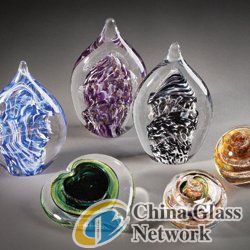
Inside the growing trend of artistic, alternative memorials
When it comes to death, no two cultures mourn the same way—Egyptian pharaohs were ceremoniously mummified, Vikings would set warrior boats on fire, Buddhist monks let nature reclaim the mortal vessel, among others. Here in the Glass City, a handful of local glass artists create memorial glass pieces which incorporate the cremated remains, or cremains, of deceased loved ones.
Matthew Paskiet, owner and artist of Firenation Glass Studio and Gallery, offers the service and makes a few pieces each month. "It’s a fun way to incorporate an ancient form of glass with a modern twist and sentimental value," he says.
When making a memorial glass piece, a client will first help an artist select the colors and design. The pieces are created like normal glass works except a sparse amount of cremains are added before the marvering process, when the glass is shaped and colored. It is then cooled over a 24-hour period. If successful, the ashes turn a brilliant white that can be visually striking.
The creative process can be an emotional experience for the artist. Gretchen Schroeder, artist at Glass Whispers, which specializes in memorial glass, says a prayer before starting a piece and treats the ashes very reverently. “The fact that you’re making something that people can then revere and feel connected to their loved one, that just makes me feel so good,” she says.
Rich Schroeder, Glass Whispers business manager and Gretchen’s husband, fondly remembers the first time he saw the memorial glass with his mother’s cremains. “We held it up to a window, and the ashes actually had facets and they would sparkle back. It was gorgeous.”
Paskiet says he is humbled and honored every time he’s asked to create a piece. “It’s a solemn thing when I’m doing it. I’ll get quiet and I’ll think respectfully of the people.”
There are sveral challenges in creating memorial glass, with the most obvious being the offbeat nature of the piece. “People think it’s either cool or it’s creepy,” Gretchen says, adding that simply approaching people can be difficult. “Marketing has been a challenge to a certain extent because it is sort of an after-market thing and how do you reach that audience?” Rich understands the stigma but thinks it shouldn’t apply. “You’re doing something artistic. I don’t think they should put any caveats on artwork.”
“It’s not for everybody, it can be really tough for some people to think about something like that; it goes against their grain,” Paskiet says. “But other people are really comforted by it and enjoy the presence.”
Additionally, the same obstacles inherent in regular glass-making—cracks, creases, misshapen forms, etc.—are still present with memorial glass.
For most people, though, any challenges or cultural aversions are outweighed by the individual value and meaning a memorial glass holds for someone. “It kind of frees the spirit in a way,” Rich says.





